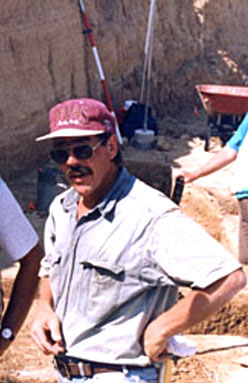Credits and Sources |
|
Learning from Cabeza de Vaca was written by Alston V. Thoms, associate professor of anthropology at Texas A&M University, where he also directs the Archaeological-Ecology Laboratory. The exhibit was created by TBH editor Susan Dial and developed for the web by Editorial Assistant Heather Smith, who also created image collages. The Southern Texas Archaeological Association and individual donors, including members of the Texas Archeological Society, provided funds for this exhibit. Thoms' research interests center on the hunter-gatherers of North America and include land-use practices, tool-stone and cook-stone technology, heritage resources management, site-formation processes, archeological ecology, and cooperative research with American Indians and other archeological stakeholders. He has carried out extensive archeological field research for over three decades in Texas, the Pacific Northwest, the Southwest, and the Southeast. Thoms' fieldwork in Texas spans more than 30 years, during which time he has worked closely with avocational archeologists, Native American groups, Civil War enthusiasts, and local historical organizations. Thoms is a sixth-generation Texan whose archeological interests date to his grade-school days in the Texas Panhandle when his father taught him how to find Indian campsites around playa lakes and along draws. A valued editorial advisor to TBH since its inception, Thoms contributions to Texas Beyond History include collaborations on the Camp Ford and Richard Beene site exhibits. To learn more about his research interests and accomplishments, see Thoms' TAMU faculty profile. Images used throughout the exhibit derive from a variety of sources. Most of the photos and graphics, unless otherwise spcified, were provided by Thoms. Phil Dering provided additional images of useful plants. Jack Johnson, archeologist and interpretive guide at Seminole Canyon State Park, created two new drawings specifically for this exhibit: a scene of native women digging roots and a depiction of the various trade goods carried by Cabeza de Vaca during his time as a trader. Other artwork includes the paintings of Ted DeGrazia, made available courtesy of the DeGrazia Foundation, and the mural art of Nola Davis, courtesy of Texas Parks and Wildlife Department. Author's acknowledgements: Several reviewers offered comments and suggested changes to an earlier version of this essay. Their input is greatly appreciated, as it made this a more factual and readable essay. TBH co-editors Susan Dial and Steve Black were especially helpful and Heather Smith did a fine job of formatting the document and integrating graphics. Ken Brown, Phil Dering, and William Foster also provided useful technical comments that improved the quality of the text. |
|
Linkswww.texasbeyondhistory.net/st-plains/nature/plants.html www.texasbeyondhistory.net/pecos/ethnobot.html www.landheritageinstitute.org/ Applewhite Bears More Fruit www.library.txstate.edu/swwc/cdv/index.html Print SourcesAdorno, Rolena and Patrick Charles Pautz Black, Stephen L., Linda Ellis, Darrell G. Creel, and Glenn T. Goode Cabeza de Vaca, Alvar Nunez Campbell, T. N. and T. J. Campbell Covey, Cyclone (translator and editor) DeGrazia Foundation Dering, J. Philip Favata, Martin. A., and José B. Fernández Foster, William C. Foster, William C. (editor) 1998 The La Salle Expedition to Texas: The Journal of Henri Joutel, 1684-1687. Griffen, William B. Hester, Thomas R. 1998 “Coahuiltecan”: A Critical Review of an Inappropriate Ethnic Label. La Tierra 25(4):3-7. Hodge, Frederick W. (editor) Howard, David A. Krieger, Alex Thoms, Alston V. 1993 Indian Land Use: Examples and Patterns in the Ethnohistorical and Archaeological Records. In The Brazos Valley Slopes Archaeological Project: Cultural Resources Assessments for the Texas A&M University Animal Science Teaching and Research Complex, Brazos County, Texas, edited by Alston V. Thoms, pp. 21-32. Archaeological Research laboratory, Reports of Investigation, Texas A&M University, College Station. 1998 Earth Ovens and Plateau Roots Foods. In Archaeology of Prehistoric North America: An Encyclopedia, edited by Guy Gibbon, pp. 232-235, 664-666. Garland Publishing, Inc., New York. 2001 Introduction to a Lineal Descent and Cultural Affiliation Study for Mission San Juan Capistrano, Texas. In Reassessing Cultural Extinction: Change and Survival at Mission San Juan Capistrano, Texas. , edited by Alston V. Thoms, pp. 1-20. Reports of Investigation No. 4, Joint Publication of the Center for Ecological Archaeology, Texas A&M University, College Station and San Antonio Missions National Historic Park, San Antonio. 2004 Native American Land Use in the Yegua Creek Basin and Vicinity: Ethnohistoric and Archaeological Records. In Yegua Creek Archaeological Project: Survey Results from Lake Somerville State Parks ad Trailway, East-Central Texas, edited by Alston V. Thoms, pp. 35-48. Reports of Investigations No. 5. Center for Ecological Archaeology, Texas A&M University, College Station. Thoms, Alston V. and Rolfe D. Mandel (editors) Wandsnider, Luanne |
